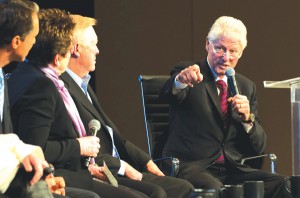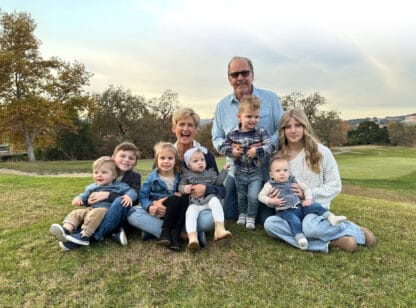
President Bill Clinton calls for action with panelists Richard Gephardt, Billie Jean King, and Dr. Mark Hyman. Photo Credit: Barbara Kinney / Clinton Foundation
The internationally-acclaimed Clinton Foundation chose the Coachella Valley for their annual ‘Health Matters’ conference bringing industry and local leaders together to discuss our country’s health crisis and the need for change. The message was clear. Change starts with each and every one of us.
“We hope that through the work that we are doing with Humana and the PGA Tour, we will encourage every single person to make a personal commitment to lifelong wellness and to be involved with family and community to encourage healthy living in others.”
Why is this important now? Childhood obesity is our #1 health problem and threatens a generation that will live shorter lives than their parents. Baby Boomers are aging and thus wreaking havoc on the country’s normal expansive demographic distribution. “We must recognize that our children’s ability to raise our grandchildren depends upon our not consuming as many health care dollars per capita as people our age have been consuming over the past 30 years,” said Clinton. “We have to stay healthier. We have no right to continue to take away from future generations.”
And there are no excuses. Each of us is responsible and we have to work together.
It’s easy to blame lack of funding support federally or locally, noted fitness pro Jillian Michaels, but these are the times when everyone needs to step up, get creative and more involved. “You do have the ability to change. It doesn’t cost anything. What it requires is passion, innovation and commitment. The solutions and answers are there.”
Individuals
We need to take back our health in our own homes, our faith-based organizations, and in our communities. This problem is going to be solved in community with everyone helping each other.
What does health mean to you? How are these changes going to affect every aspect of my life? Identify your reason for wanting to change and know that every single one of us is an influencer and has an opportunity to make a difference.
Lakeysha Sowunmi, a young mom and community advocate, spent four years trying to convince her church members to change the fish fry and chicken dinners to healthier meals. She created a model which she now takes to other community churches.
Being healthy is a lifestyle, not what you can do during one hour of your day, but the dozens of choices you make throughout your day.
Parents
Most of us eat the way we eat and live the way we live because we were raised this way. Studies show that children who grow up on fruits and vegetables, LIKE fruits and vegetables. Parents are the greatest role models and education is key.
Traditions in families and cultures may conflict with healthy choices. So behaviors need to be changed – in every community and in every household. How can you be a positive agent of change for your family and community?
- If you haven’t walked through your kids’ school, take a tour. See what healthy and unhealthy influences are there and get involved.
- Create or join a school wellness council.
- For birthday celebrations, instead of cookies and cakes, create a special activity or a special healthy meal your child chooses.
- Eat dinner at the table with your kids at least 3 times per week.
- If gym class was cut from your school, take turns with other parents to run gym class one day a week after school.
- Organize a school or community garden for kids and parents to tend together – or start a community fruit and vegetable co-op for greater buying power on healthy foods.
Employers
This country spends $1 trillion a year on wasted productivity due to people not being well, states Mike McAllister of Humana. 70% of medical costs are due to smoking, food choices and stress. If you cut those things, you cut your health care costs.
McAllister cited an employer in Ohio whose health care costs were rising 12% a year due to smokers and diabetes. The employer offered to pay for smoking cessation programs individuals chose. He also built a gym in his facility. In two years, smoking incidents went from 30 to 4%. And employees are working together to lose weight. The company’s health care cost growth rate is down to 3% a year.
It has to be a priority at the top and easy to implement. James Curleigh, CEO of Keen footwear, promotes fun breaks for employees. Remember when employees were free to take smoke breaks? But recess, which was created in 1854 to give kids a break to improve focus, would be frowned upon. Change that, he says. “Encourage people to create, play and to care. Bring back recess.”
Ideas?
- Empower employees to come up with ideas and implement them.
- Create employee incentive and rewards platforms based on good health.
- Change cafeteria food to eliminate unhealthy options.
- Build a culture around the subject of health and make it easy and fun for employees.
- Nominate a wellness advocate within the organization to educate and motivate both employees and the company.
- Draw hopscotch at the doorway or put a hula hoop in the corner. Encourage movement throughout the day.
Places of Faith
Saddleback Church in Southern California has 30,000 members and an average weight of 170 lbs for women and 250 lbs for men. Working with Dr. Mark Hyman, the pastor implemented a group program aimed at improving member health. On the day they launched the program, over 8,000 people signed up to participate and within a week over 15,000 joined. In the first year, the congregation lost over 250,000 pounds, changing the complexion of the church forever. Saddleback’s successful program is now used as a model for other church groups. (www.drhyman.com)
Community is more effective than any medication, says Hyman. Start by simply changing the menu at church functions.
School Administrators
55 million kids in this country are in school and will spend between 12-15,000 hours there before graduating. Schools have to take part in this movement. People who work with school districts understand the challenges, but change is possible.
The Alliance for a Healthier Generation found that 40-50% of kids’ daily caloric intake was from drinks at schools. In four years, they achieved an 88% reduction in caloric content of beverages in 12,000 schools within their Healthy Schools program.
Dr. Howell Wechsler, Division Director for Adolescent and School Health, Centers for Disease Control and Prevention stated 5 critical points:
- Schools must be greatly involved in activating wellness.
- Promoting health needs to be a fundamental part of the mission of our schools.
- We know what needs to be done, but there is a lack of implementation. CDC provides tools for schools,; they just need to act.
- Promoting health needs to be integrated into school accountability requirements (health councils and quantifiable programs must be implemented).
- No progress will be made unless policy makers are made to understand that it is not acceptable to cut gym class and school wellness programs.
The Durham, NC public school system has 33,000 students. 66% are on free and reduced lunch programs. The district has been working with the Healthy Schools program for 3 1/2 years. “Now we have one of the most aggressive wellness campaigns in the state,” says Pete Shankle, wellness coordinator. Every school has a wellness council and must turn in a wellness plan with short and long term goals, along with means of measurements. Each of the 54 schools takes an assessment to determine where they are and how far they have to go. District policies have created a chance for all the schools to achieve awards from the Alliance.
- We need to change the defaults to change the culture of schools, says Clinton. Examples include:
- Create healthy councils of kids and staff to generate program ideas and teamwork.
- Instead of gold stars, hand out red apple stickers. A small gesture, but it shows that we value apples the same as gold bullion or a star in the sky.
- Open school playgrounds and sports fields off-hours to allow kids and parents a place to play and be active.
- Create summer challenges: How many steps can you all take before coming back in the Ffall (which can easily be done through the Valley’s Healthy Lifestyle Challenge (below)
A district in Minnesota stopped allowing kids to drink or eat in the hallways or classrooms. Their weight went down 10% without altering anything else in health or exercise. Seemingly small changes can make a difference in the health of our students.
We all need to play a role in resolving our country’s national health crisis. Clinton’s ‘Health Matters’ conference highlighted the issues, discussed the opportunities – and offered us inspiration for positive change.
Working together, we can effectively combat childhood obesity and deal with the challenges of the aging baby boomer population. We can become healthier as individuals, and build stronger, longer-living communities around healthy living principles.
“Every human being has the responsibility to live as long as you can and to help others do so,” concluded Clinton. “Everybody’s got to be part of this effort. If we make this a national culture change, we will make a difference.”
For more information or to view the conference visit www.clintonfoundation.org/healthmatters











































Comments (0)